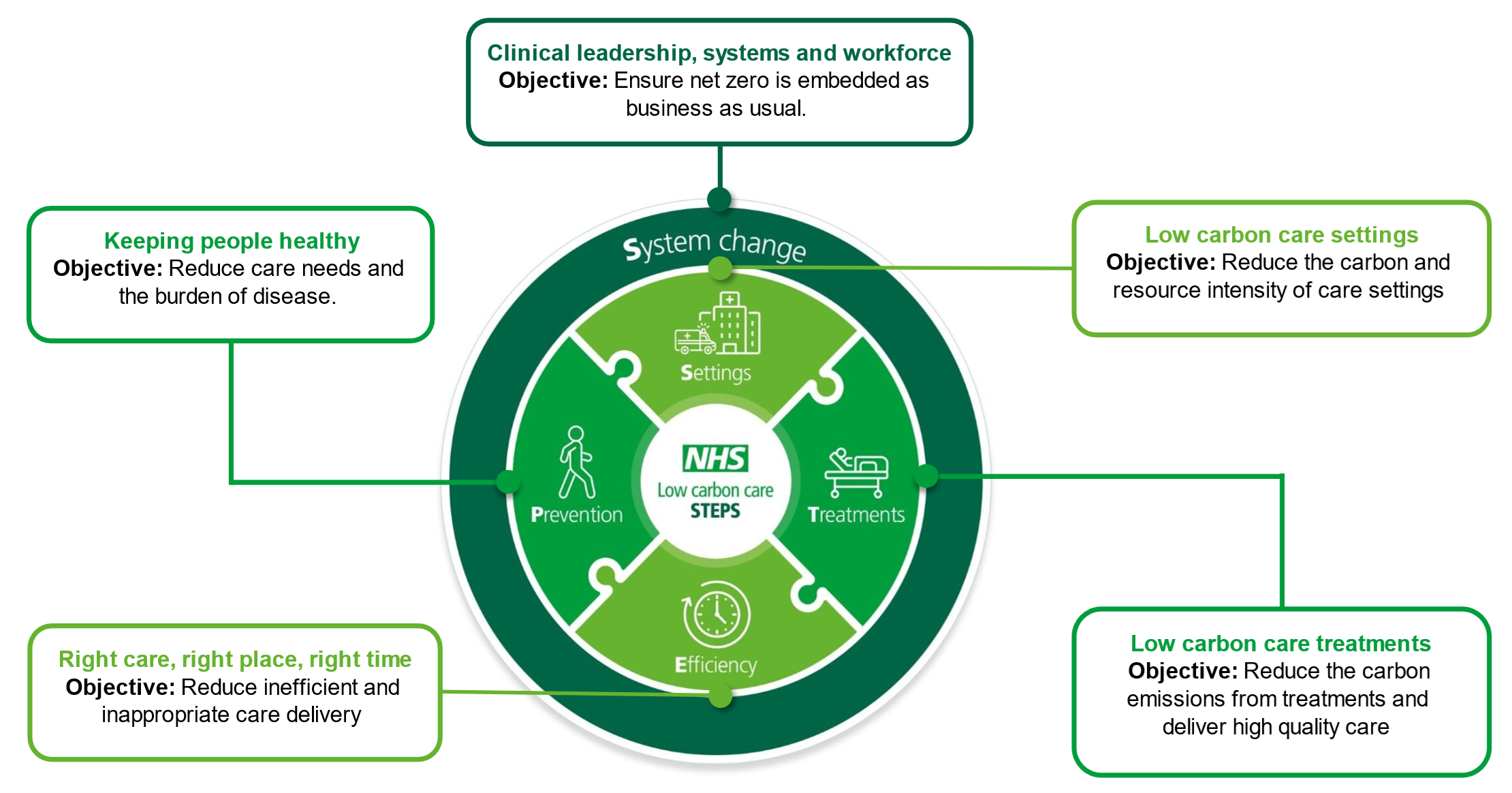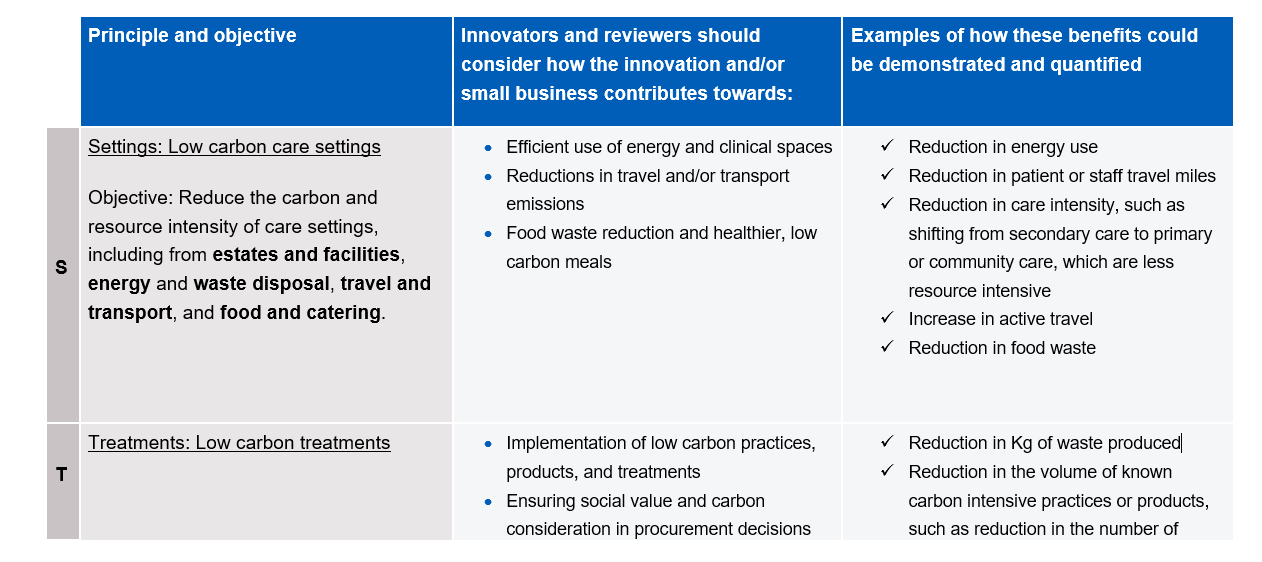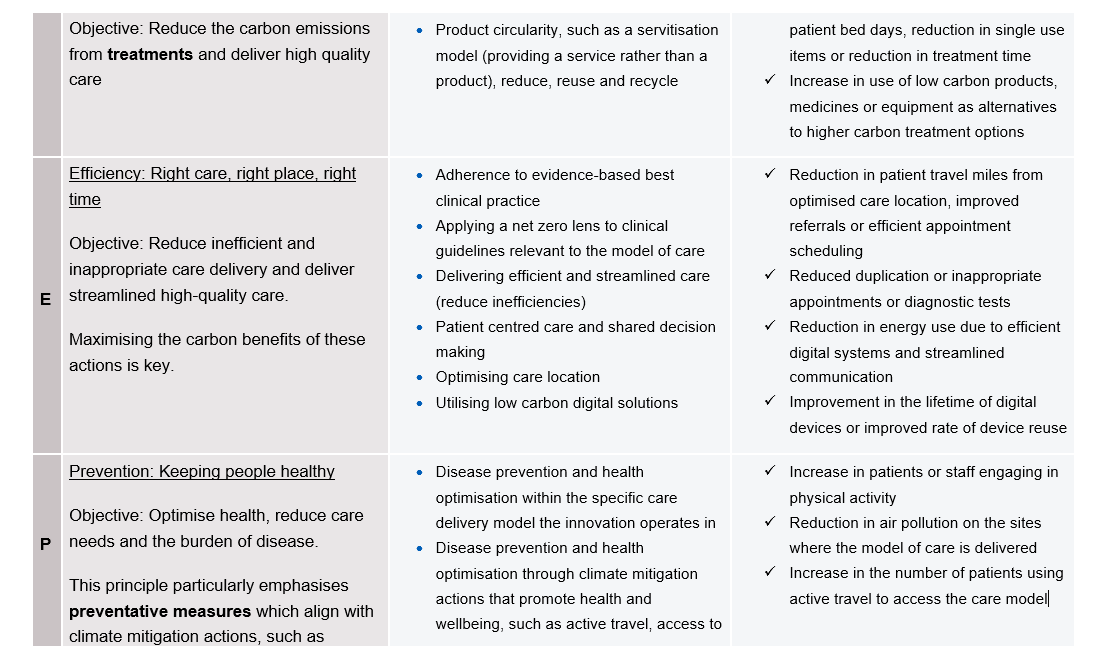

STEPS to Low Carbon Care Delivery - Supporting materials for SBRI Healthcare
Purpose
This guidance has been created to support applicants, innovators, and assessors of all SBRI Healthcare innovation programmes in demonstrating and assessing how they meet the net zero assessment criteria. This is through using a new assessment framework, NHS England’s low carbon STEPS approach, to assess the impact of innovation on care delivery from a carbon emissions perspective.
The guidance is not intended to be prescriptive or seen as a fully comprehensive or validated assessment framework for meeting the SBRI Healthcare net zero assessment criteria. It is intended to increase understanding of net zero clinical transformation and provide guidance to (i) support innovators in assessing the carbon impact of their innovation on care pathways and (ii) for assessors to review the responses according to the net zero assessment criteria.
Background and Context
The NHS has committed to reach net zero carbon emissions by 2040 for directly controlled emissions, and by 2045 for emissions the NHS influences, including emissions from all its suppliers. Net zero is now embedded in legislature through the Health and Care Act 2022, which places a duty on all NHS organisations to consider climate change in their operations. All 212 NHS trusts and 42 ICSs have a Green Plan, their strategy to reach net zero, in place and being implemented.
Innovation is a crucial part of our journey to net zero and innovators have an important role to play in meeting the NHS net zero targets and statutory asks, for three key reasons:
- Innovators are current and future suppliers to the NHS
As suppliers to the NHS, innovators will directly contribute to its scope 3 emissions associated with the supply chain. This constitutes around 60% of the NHS carbon footprint and is therefore a key focus both nationally and locally across Green Plans. Guidance on aligning with the NHS’ net zero supply chain commitments can be found on the Greener NHS webpage.
- Innovations will enable net zero clinical practice
Innovative solutions will be required to drive net zero clinical care: transforming how care is delivered in a way that supports the delivery of equitable, low carbon care whilst maintaining or improving the access, quality and efficiency of care. This makes innovators uniquely placed to deliver on this opportunity.
- Innovators influence clinical practice
Clinical practice, including the decisions, processes, practices, and products that determine what, how, when and where care is delivered, underpins the carbon footprint of the NHS. Innovators and innovations that affect clinical practice and care delivery, through improvement, disruption and redesign, therefore have the potential to influence the carbon impact of care, across a care pathway, service, or treatment type.
A care pathway-orientated approach is required to understand the impact of the innovations on the carbon emissions of care delivery, whilst ensuring safe, efficient and equitable care. This approach must position and assess the innovation across the whole patient pathway and consider its carbon impact alongside other health and financial outcomes.
The Low Carbon Care STEPS
The NHS has developed a principle-based approach to transforming clinical care towards net zero: the low carbon care STEPS (low carbon care ‘Settings and Treatments, Efficiency, Prevention and System change’).
Applying the low carbon care STEPS to innovation serves as the starting point to identifying and assessing areas where the proposed innovation supports net zero clinical transformation.
The STEPS are based on the rationale that every care component has an associated carbon footprint. The footprint will therefore increase where care needs are high and complex, care delivery is inefficient and inappropriate, care settings and treatments are resource and carbon intensive, and if the systems in which we work fail to embed net zero as core business-as-usual.

Figure 1: Infographic of the Low Carbon Care STEPS framework, detailing the objective of each principle.
The STEPS framework forms an integral part of the NHS’ strategy to delivering net zero clinical care, alignment with which will become increasingly important in clinical decision making. Innovators can use this guidance to assess their impact and demonstrate carbon reduction benefits across the different areas of clinical care.
Why start with this principle-based approach?
Quantifying the impact of innovations on the carbon emissions of clinical care can be complex. This guidance therefore aims to support innovators to build a narrative to demonstrate the potential impact of their innovation, in alignment with the STEPS, and measure this through non-carbon-specific metrics in the initial stages.
How to use this guidance
The table below outlines each of the STEPS in turn. For each, there are several points to consider on how the innovation may support each area within the model of care it operates in (i.e., care pathway, service, or treatment delivery model), and/or how the organisation supports these points in its own operations. Examples of how these could be quantified or reported on are also included to aid innovators to demonstrate the benefits. These points and example measures are by no means exhaustive, and serve as illustrations, to provide guidance and a potential roadmap for assessing the impact of the innovation on the care pathway.



